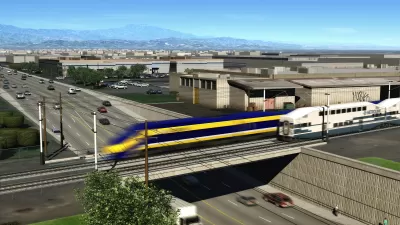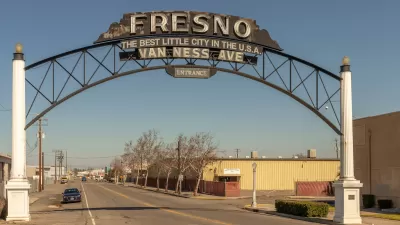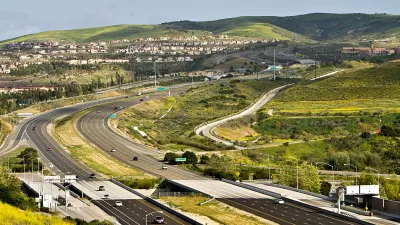In spite of a host of problems, over 1,000 parcels have been acquired and construction is occurring in nine areas in the Central Valley, centering on Fresno. Limited service from San Francisco to Bakersfield could begin in 2025.

"America’s biggest infrastructure project is both in limbo and full-speed ahead," reports Kurtis Alexander for the San Francisco Chronicle. It's become the poster child of boondoggles for Republicans in Sacramento and the nation's capital, but in the Central Valley, particularly around its largest city, Fresno, it's presence can not be overlooked, literally-speaking in some areas.
Far from the wrangling in Sacramento and Washington, work on the first 119-mile segment, from Madera to just outside Bakersfield, has been under way for almost two years.
Just south of downtown Fresno, the largest undertaking so far — a half-mile-long viaduct that will lift trains from the city into distant farmland — is taking shape in an area of old factories and warehouses. Already, the new structure is a monolith helping define the Fresno skyline....The columns of the superstructure stand nearly 80 feet tall, while the bridge deck is emerging as a sleek, aerial concourse.
It’s very satisfying to see,” said California High-Speed Rail’s Central Valley director, Diana Gomez, as she led a tour of the loud, muddy construction site. “Everyone can see this piece from Highway 99.”
Alexander writes that the project is not being done in one, expanding location, as one might expect, but at nine major sites. Twelve miles north of the Fresno viaduct described above, "a nearly mile-long viaduct is rising over the San Joaquin River, while about 25 miles to the north, in Madera County, a bridge is materializing across the Fresno River."
One of the most significant activities, moving six lanes of Highway 99 about 100 feet to the west for 2 miles, will allow trains to squeeze through a dense part of central Fresno.
“There’s really no place yet you can stand and see for miles and miles and say, ‘Yeah, it’s coming together,’” said Dan Richard, chair of the Rail Authority's governing board, looking up at the emerging bridge over the San Joaquin River. “But once these few projects get done, connecting them comes fast.”
However, litigation by opponents living in the Central Valley, "planning snafus and problems with land acquisitions have set the project back at least three years."
It's uncertain whether the first, 500-mile phase from San Francisco to San Jose, will receive sufficient funding to be built. The California High-Speed Rail Authority was expecting to receive more federal funding, which Congress has since eliminated, and although some private rail operators have shown some interest, none are willing to invest in the project, unlike the nation's other high-speed rail project connecting Dallas to Houston.
"Texas Central Partners plans to begin construction on the rail in late 2017 and will work closely with Japan Railway to localize the firm’s Shinkansen bullet train technology," reported Bill Hethcock for the Dallas Business Journal last May. "The project is scheduled for completion in 2021 with the first full year of operations in 2022."
The California High-Speed Rail Authority hopes to launch bullet trains from San Francisco to Bakersfield by 2025, but without new funding, running tracks to Los Angeles will be challenging.
FULL STORY: High-speed rail taking shape even as opponents seek to kill it

Maui's Vacation Rental Debate Turns Ugly
Verbal attacks, misinformation campaigns and fistfights plague a high-stakes debate to convert thousands of vacation rentals into long-term housing.

Planetizen Federal Action Tracker
A weekly monitor of how Trump’s orders and actions are impacting planners and planning in America.

In Urban Planning, AI Prompting Could be the New Design Thinking
Creativity has long been key to great urban design. What if we see AI as our new creative partner?

King County Supportive Housing Program Offers Hope for Unhoused Residents
The county is taking a ‘Housing First’ approach that prioritizes getting people into housing, then offering wraparound supportive services.

Researchers Use AI to Get Clearer Picture of US Housing
Analysts are using artificial intelligence to supercharge their research by allowing them to comb through data faster. Though these AI tools can be error prone, they save time and housing researchers are optimistic about the future.

Making Shared Micromobility More Inclusive
Cities and shared mobility system operators can do more to include people with disabilities in planning and operations, per a new report.
Urban Design for Planners 1: Software Tools
This six-course series explores essential urban design concepts using open source software and equips planners with the tools they need to participate fully in the urban design process.
Planning for Universal Design
Learn the tools for implementing Universal Design in planning regulations.
planning NEXT
Appalachian Highlands Housing Partners
Mpact (founded as Rail~Volution)
City of Camden Redevelopment Agency
City of Astoria
City of Portland
City of Laramie




























